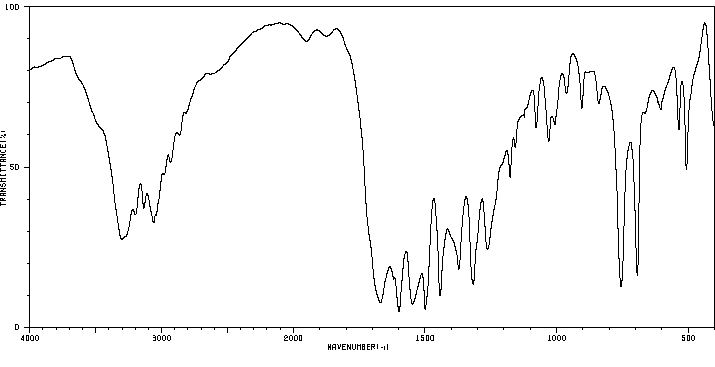1,4-diphenyl-2,3-dimethyl-1,4-diazabutadiene | 84679-62-9
中文名称
——
中文别名
——
英文名称
1,4-diphenyl-2,3-dimethyl-1,4-diazabutadiene
英文别名
(E,E)-N,N′-diphenylbutane-2,3-diimine;(E,E)-N,N'-(butane-2,3-diylidene)dianiline;N,N'-bis(phenyl)-2,3-butanediimine
CAS
84679-62-9
化学式
C16H16N2
mdl
——
分子量
236.316
InChiKey
KLYTUKWIWXAUFO-HBKJEHTGSA-N
BEILSTEIN
——
EINECS
——
-
物化性质
-
计算性质
-
ADMET
-
安全信息
-
SDS
-
制备方法与用途
-
上下游信息
-
文献信息
-
表征谱图
-
同类化合物
-
相关功能分类
-
相关结构分类
计算性质
-
辛醇/水分配系数(LogP):4.57
-
重原子数:18.0
-
可旋转键数:3.0
-
环数:2.0
-
sp3杂化的碳原子比例:0.12
-
拓扑面积:24.72
-
氢给体数:0.0
-
氢受体数:2.0
反应信息
-
作为反应物:描述:1,4-diphenyl-2,3-dimethyl-1,4-diazabutadiene 、 丙酰氯 在 三乙胺 作用下, 以 甲苯 、 苯 为溶剂, 以73.2%的产率得到rac-(3R,4R)-3,4-dimethyl-1-phenyl-4-[(E)-1-(phenylimino)-ethyl]azetidin-2-one参考文献:名称:邻二胺和酰氯反应的选择性摘要:在三乙胺的存在下,邻位二亚胺与酰氯的反应产生3-亚氨基-β-内酰胺和/或双-β-内酰胺,具有化学,区域和立体选择性,它们是药物和有机合成中的重要中间体。已经研究了反应中的选择性。结果表明,由于二乙胺的吸电子性,所有的二亚胺在三乙胺的存在下与酰基氯生成的各种烯酮反应生成非对映选择性的顺式-4-亚氨基-β-内酰胺(单-顺式-β-内酰胺)。邻近的二亚胺中的亚氨基。通过单顺式-β-内酰胺作为中间体从二亚胺获得双-β-内酰胺。只有具有强电子给体取代基的乙烯酮才能与单顺-β -内酰胺,得到双- β内酰胺,得到一对C 2 -对称的顺式-双-β内酰胺具有对称二亚胺,两个或4双非对映体双- β内酰胺与酮醛衍生的非对称二亚胺取决于它们的N-取代基的空间位阻。当前的研究为从邻二甲基亚胺选择性制备单-和双-β-内酰胺提供了非常重要的信息。DOI:10.1016/j.tet.2011.10.044
-
作为产物:参考文献:名称:合成外-咪唑啉-2-酮二烯,它们的异构化,和选择性尔斯-阿尔德环加成摘要:描述了外-咪唑烷基-2-酮二烯的有效和替代合成。用双亚氨基衍生物,二乙酰基和三光气进行缩合反应,得到对称的N,N-二取代的二烯。烷基甲基α-二酮的使用导致不对称二烯的形成,对其进行异构化以在路易斯酸条件下提供更稳定的内外环二烯。评估了这些二烯在Diels-Alder反应中的反应性以及区域和立体选择性。他们被证明是高度反应性和选择性的。过渡态的DFT计算说明了它们的行为。DOI:10.1021/acs.joc.7b02344
文献信息
-
Metal Complexes
-
[EN] METHODS OF PRODUCING ALPHA, BETA-UNSATURATED CARBOXYLIC ACID SALTS FROM ALKANES AND CARBON DIOXIDE<br/>[FR] PROCÉDÉS DE PRODUCTION DE SELS D'ACIDE CARBOXYLIQUE ALPHA, BÊTA-INSATURÉS À PARTIR D'ALCANES ET DE DIOXYDE DE CARBONE申请人:SABIC GLOBAL TECHNOLOGIES BV公开号:WO2019053540A1公开(公告)日:2019-03-21Methods of producing α,β-unsaturated carboxylic acid salt are described. A method can include reacting an alkene and carbon dioxide with a composition that includes a carboxylation catalyst, an organic base that is solubilized in the composition, and an inorganic base that is not solubilized in the composition, under reaction conditions suitable to produce an inorganic base salt of an α,β-unsaturated carboxylic acid. The organic base can have a first pKa and the inorganic base has a second pKa that is greater than the first pKa.
-
Reactions of ruthenium triphenylphosphine complexes with diazadienes. Part 1. Reactions of [RuCl2(PPh3)3] and [RuH(Cl)(PPh3)3] and disproportionation of a hydridochloro-complex作者:Bruno Chaudret、Rene PoilblancDOI:10.1039/dt9800000539日期:——The reactions between [RuCl2(PPh3)3] and half or one equivalent of a diazadiene (dad) give respectively molecular and ionic binuclear triply chloro-bridged complexes, [Ru2Cl4(PPh3)3(dad)] and [Ru2Cl3(PPh3)2(dad)2]Cl which can also be obtained as its B Ph4 salt. The compound [RuH(Cl)(PPh3)3] reacts with diazadienes to produce [RuH(Cl)(PPh3)2(dad)], which disproportionates in polar solvents to give a
-
[EN] AROMATIC MONOMER-AND CONJUGATED POLYMER-METAL COMPLEXES<br/>[FR] COMPLEXES METALLIQUES A BASE DE MONOMERE AROMATIQUE ET DE POLYMERE CONJUGUE申请人:DOW GLOBAL TECHNOLOGIES INC公开号:WO2005016945A1公开(公告)日:2005-02-24A halogenated aromatic monomer-metal complex useful for preparing a polymer for electronic devices such as a light-emitting diode (LED) device is described. The aromatic monomer-metal complex is designed to include a linking group that disrupts conjugation, thereby advantageously reducing or preventing electron delocalization between the aromatic monomer fragment and the metal complex fragment. Disruption of conjugation is often desirable to preserve the phosphorescent emission properties of the metal complex in a polymer formed from the aromatic monomer-metal complex. The resultant conjugated electroluminescent polymer has precisely controlled metal complexation and electronic properties that are substantially or completely independent of those of the polymer backbone.
-
Synthesis and Diels–Alder Cycloadditions of <i>exo</i>-Imidazolidin-2-one Dienes作者:Rafael Bautista、Pablo Bernal、Rafael Herrera、Blanca M. Santoyo、J. Miguel Lazcano-Seres、Francisco Delgado、Joaquín TamarizDOI:10.1021/jo201335y日期:2011.10.7An efficient and versatile synthesis of novel exo-imidazolidin-2-one dienes is described. This involves the base-assisted condensation/cyclization cascade reaction of the monoimino derivatives of diacetyl with a series of isocyanates. This methodology enables preparation of symmetrical dienes, as long as the substrates have the same N substituent. Moreover, use of different N-substituted starting materials
表征谱图
-
氢谱1HNMR
-
质谱MS
-
碳谱13CNMR
-
红外IR
-
拉曼Raman
-
峰位数据
-
峰位匹配
-
表征信息
同类化合物
(βS)-β-氨基-4-(4-羟基苯氧基)-3,5-二碘苯甲丙醇
(S,S)-邻甲苯基-DIPAMP
(S)-(-)-7'-〔4(S)-(苄基)恶唑-2-基]-7-二(3,5-二-叔丁基苯基)膦基-2,2',3,3'-四氢-1,1-螺二氢茚
(S)-盐酸沙丁胺醇
(S)-3-(叔丁基)-4-(2,6-二甲氧基苯基)-2,3-二氢苯并[d][1,3]氧磷杂环戊二烯
(S)-2,2'-双[双(3,5-三氟甲基苯基)膦基]-4,4',6,6'-四甲氧基联苯
(S)-1-[3,5-双(三氟甲基)苯基]-3-[1-(二甲基氨基)-3-甲基丁烷-2-基]硫脲
(R)富马酸托特罗定
(R)-(-)-盐酸尼古地平
(R)-(-)-4,12-双(二苯基膦基)[2.2]对环芳烷(1,5环辛二烯)铑(I)四氟硼酸盐
(R)-(+)-7-双(3,5-二叔丁基苯基)膦基7''-[((6-甲基吡啶-2-基甲基)氨基]-2,2'',3,3''-四氢-1,1''-螺双茚满
(R)-(+)-7-双(3,5-二叔丁基苯基)膦基7''-[(4-叔丁基吡啶-2-基甲基)氨基]-2,2'',3,3''-四氢-1,1''-螺双茚满
(R)-(+)-7-双(3,5-二叔丁基苯基)膦基7''-[(3-甲基吡啶-2-基甲基)氨基]-2,2'',3,3''-四氢-1,1''-螺双茚满
(R)-(+)-4,7-双(3,5-二-叔丁基苯基)膦基-7“-[(吡啶-2-基甲基)氨基]-2,2”,3,3'-四氢1,1'-螺二茚满
(R)-3-(叔丁基)-4-(2,6-二苯氧基苯基)-2,3-二氢苯并[d][1,3]氧杂磷杂环戊烯
(R)-2-[((二苯基膦基)甲基]吡咯烷
(R)-1-[3,5-双(三氟甲基)苯基]-3-[1-(二甲基氨基)-3-甲基丁烷-2-基]硫脲
(N-(4-甲氧基苯基)-N-甲基-3-(1-哌啶基)丙-2-烯酰胺)
(5-溴-2-羟基苯基)-4-氯苯甲酮
(5-溴-2-氯苯基)(4-羟基苯基)甲酮
(5-氧代-3-苯基-2,5-二氢-1,2,3,4-oxatriazol-3-鎓)
(4S,5R)-4-甲基-5-苯基-1,2,3-氧代噻唑烷-2,2-二氧化物-3-羧酸叔丁酯
(4S,4''S)-2,2''-亚环戊基双[4,5-二氢-4-(苯甲基)恶唑]
(4-溴苯基)-[2-氟-4-[6-[甲基(丙-2-烯基)氨基]己氧基]苯基]甲酮
(4-丁氧基苯甲基)三苯基溴化磷
(3aR,8aR)-(-)-4,4,8,8-四(3,5-二甲基苯基)四氢-2,2-二甲基-6-苯基-1,3-二氧戊环[4,5-e]二恶唑磷
(3aR,6aS)-5-氧代六氢环戊基[c]吡咯-2(1H)-羧酸酯
(2Z)-3-[[(4-氯苯基)氨基]-2-氰基丙烯酸乙酯
(2S,3S,5S)-5-(叔丁氧基甲酰氨基)-2-(N-5-噻唑基-甲氧羰基)氨基-1,6-二苯基-3-羟基己烷
(2S,2''S,3S,3''S)-3,3''-二叔丁基-4,4''-双(2,6-二甲氧基苯基)-2,2'',3,3''-四氢-2,2''-联苯并[d][1,3]氧杂磷杂戊环
(2S)-(-)-2-{[[[[3,5-双(氟代甲基)苯基]氨基]硫代甲基]氨基}-N-(二苯基甲基)-N,3,3-三甲基丁酰胺
(2S)-2-[[[[[((1S,2S)-2-氨基环己基]氨基]硫代甲基]氨基]-N-(二苯甲基)-N,3,3-三甲基丁酰胺
(2S)-2-[[[[[[((1R,2R)-2-氨基环己基]氨基]硫代甲基]氨基]-N-(二苯甲基)-N,3,3-三甲基丁酰胺
(2-硝基苯基)磷酸三酰胺
(2,6-二氯苯基)乙酰氯
(2,3-二甲氧基-5-甲基苯基)硼酸
(1S,2S,3S,5S)-5-叠氮基-3-(苯基甲氧基)-2-[(苯基甲氧基)甲基]环戊醇
(1S,2S,3R,5R)-2-(苄氧基)甲基-6-氧杂双环[3.1.0]己-3-醇
(1-(4-氟苯基)环丙基)甲胺盐酸盐
(1-(3-溴苯基)环丁基)甲胺盐酸盐
(1-(2-氯苯基)环丁基)甲胺盐酸盐
(1-(2-氟苯基)环丙基)甲胺盐酸盐
(1-(2,6-二氟苯基)环丙基)甲胺盐酸盐
(-)-去甲基西布曲明
龙蒿油
龙胆酸钠
龙胆酸叔丁酯
龙胆酸
龙胆紫-d6
龙胆紫







